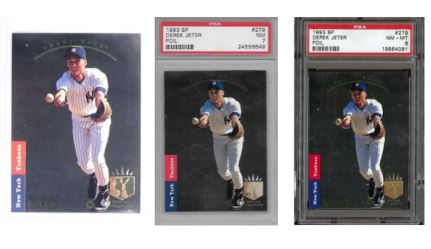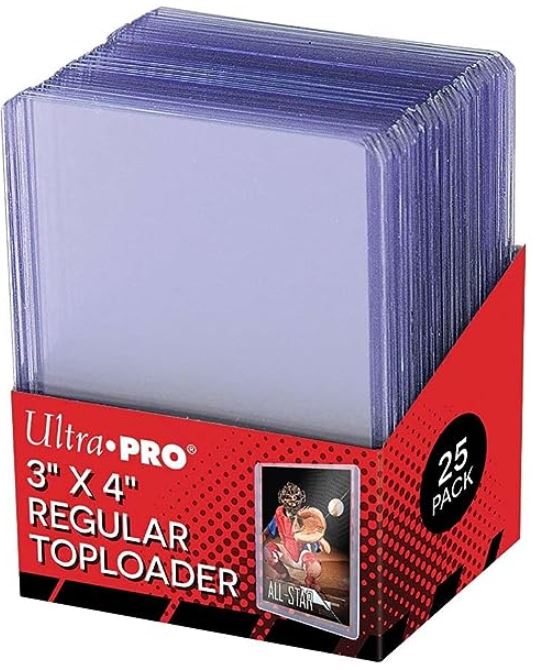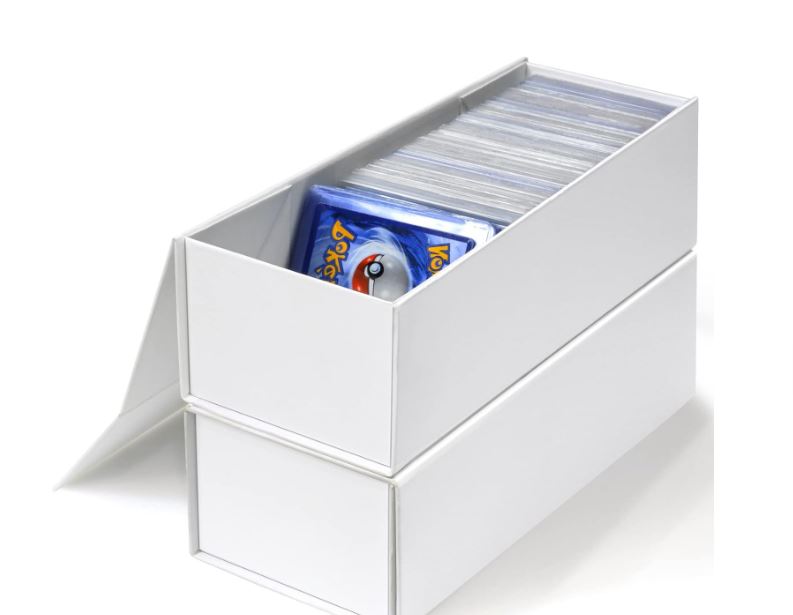It has always been essential to have your cards in good condition if you want to get a good value for them. But in recent years, that has become an absolute obsession. Grading is an integral factor in card value now. And the sharpest differences tend to be between the highest grades. While there are gradually rising differences in price as grades get higher, the differential between PSA 9 and PSA 10 is particularly striking. Sometimes, the value can be as much as ten times higher for a gem mint, especially when the population count is particularly low.
Therefore, more is needed to send a card in good condition to PSA. Very often, PSA 9s aren’t worth all that much. You want the cards you submit to have at least a good chance of getting a PSA 10 grade. But don’t worry. We have you covered in our full guide on getting the best grade possible for your cards from PSA.

What Makes A Card A PSA 10?
The condition of a card has several subjective elements. But there is a fairly detailed guide to what makes a PSA 10 on the website of the grading company.
According to PSA, these are the characteristics they expect from a PSA 10 card:
- Four perfectly sharp corners: This is one of the easiest ways to predict if your card has a chance at a PSA 10. If any of the four corners are blunted, frayed, folded, filed down, or otherwise damaged or dulled, you are unlikely to get a PSA 10.
- Sharp focus and full original gloss: If a card is out of focus compared to others like it or has an uneven or completely faded gloss, it will not be a gem mint card.
- A PSA Gem Mint 10 card must be free of staining of any kind. Still, an allowance may be made for a slight printing imperfection if it doesn't impair the overall appeal of the card: in other words, if the cards are printed with a stain or blemish, that is usually fine. But if there is a stain, even a minor one, that the card gained later, it is not a PSA 10.
- The image must be centered on the card within a tolerance not to exceed approximately 55/45 to 60/40 percent on the front and 75/25 percent on the reverse: the centering refers to the width of the borders on each side. The closer they are to being completely even (50/50), the better. The centering can be quite bad on the back of the card. But even there, some margin is maintained.
Carefully examine your card in all these parameters. The card is worth grading if it confers to the high standards that PSA maintains for a gem mint or has a reasonable chance to do so. Modern cards with no chance of obtaining a PSA 10 grade are usually not worth submitting. Vintage cards are a different story and can often be worth quite a bit, even with visible flaws.

How To Treat Your Cards To Get A High PSA Grade
Treating your cards well is one of the most critical elements in getting a PSA 10. These are valuable artifacts and should be treated as such. There are different rules for cards you get out of the pack, as opposed to those you buy raw. We will take a look at both. Then, we will look at how to submit your cards correctly. If you follow these steps carefully, you will have the best chance of getting an excellent grade on your cards.
Cards Fresh Out Of The Pack
The process of protecting your cards starts even before you open the pack. Obviously, the more valuable the brand, the more care you will want to take. Here are the proper steps for opening a pack:
- Make sure to hold the pack flat on the palm of your hand. Whatever you do, do not hold on to the corners of the pack. But also, hold it securely so that you do not drop the pack. When the product is particularly valuable, consider wearing gloves when opening it.
- Ripe the package carefully. Remove the card while holding it gently but securely from the borders again, and avoid the corners.
- Place any card you wish to submit in a card sleeve. The best material for this purpose is a poly-bag since they have lower static charges than other materials. Make sure that the card sleeve is the right size. The standard will work for most cards, but those with extra thickness, width, or length may require a different size. You can damage cards when placing them in a penny sleeve that is too small. But similarly, one too big can see cards bounce around and damage the corners. You are looking for a tight but secure fit. If you want to learn more about this, read our guide about finding the perfect top loaders to protect your trading cards.
- Next, place the card in a semi-rigid top loader. All the same caveats for size that we discussed for the penny sleeve also apply to top holders.
- Once you have secured and stored your card, the best bet is to send it off to be graded as soon as possible. The longer you keep it around, the more likely it is that something bad will happen to your card.

Buying Raw Cards Online
Many of us still buy cards at card shows or hobby shops. Those have the great advantage of allowing us to examine cards up close and look for flaws in detail. Therefore, your chances of getting a PSA 10-worthy card in person are usually higher. But seeing cards in person is not always practical before you buy them. Card shops have limited stock and also charge a premium because they have overhead.
Meanwhile, online, you can get almost any card you want. But the downside is that it can be harder to get a feel for the condition of the cards from pictures on eBay and other online shopping forums. Nonetheless, by taking some simple steps, you can avoid the biggest obstacles:
- Verify the seller's reputation: this may seem irrelevant at first glance. Even if the seller is wrong, it doesn’t matter if I find a sound card with a good picture, right? Wrong. A reputable seller will always provide you with the card in the picture. But a dishonest one can put up a picture of a beautiful-looking card and send you a slightly worse specimen. Then you are stuck trying to prove to the selling platform that the damage on the top-left corner is not the same card. I’ve been there. You don’t want to be in that position.
- High-quality pictures of the front AND back: Only consider buying a card if there are AT LEAST two pictures of the card showing all sides of the card. If there is something wrong with the card anywhere, sellers will try to hide it one way or another. If the pictures aren’t very clear, especially from a seller with other nicely done cards, it could indicate something is wrong. The front of the card is far more important for the grade. But problems in the back of the card can still drag you down a grade or two.
- If the card is REALLY valuable, you should only consider buying it if the seller provides close-up shots of all four corners. Spending thousands of dollars on a card with visible damage would be folly. Being able to see each corner separately often gives us a far better idea of the real condition of the cards than an overall scan.
- Zoom in: Most selling platforms have a beautiful feature. It always requires you to get extreme closeups on cards before purchasing them. Use it! First, look at the corners since these are most prone to damage. But also go across the borders and surface to look for flaws.
If You Must Store Your Card Before Sending It Off To Be Graded By PSA
As I said, it's best to send off the card quickly. But sometimes, life isn’t that simple, and we need to store cards for a bit before sending them off. In those cases, follow these simple steps for protecting the cards in the meantime:
- Place your cards in a cardboard box, preferably one which is a comfortable fit for cards. Boxes that are too large, such as shoeboxes, can see the cards rattle around, which again may damage them. So, your best bet is to order boxes for sports card storage.
- Even when stored in a box, keep the cards as far away from sunlight as possible. The sun is a natural enemy for cards, making the colors bleed and fading the finish.
- Do not store your expensive cards in binders. They are lots of fun for displaying complete sets of cards and can be quite convenient. Buy binders are a poor choice for costly cards. It is easy to harm the corners while getting them in or out. In addition, they can make the cards “sweat,” which causes them to stick to the plastic and can harm the coating and make colors fade.
- The other enemy of card storage is humidity. That will make your cards fold up and blister the cardboard. Therefore, your best bet is to store the cards in a climate-controlled room.
If you want to learn more about this read our Guide to Storage: How To Protect Your Trading Card Collection And Boost Its Value
Sending Cards In To Be Graded By PSA
How to package your cards for PSA submission
- PSA recommends using your standard 3" by 4 1/2" semi-rigid holders for most regular cards. You should use a top holder and painter's tape in order to shut the cards in from the top. That is particularly important if the cards are thicker ones in the 130-point or higher range.
- You will want to avoid using snap cases for grading your cards. They can break in the mail and severely damage your cards in the process.
- The trouble with semi-rigid holders is that they are not entirely rigid. Therefore, you will want to reinforce them so that your precious cards do not bend in the mail. Consequently, place the cards between two pieces of cardboard cut out to be wider than the cards in question.
- Then, use rubber bands in order to keep the pieces of cardboard together. Attach the bands tightly enough to secure the cards in place. But not so tight that they might damage them.
- Place the cards in a box roughly the size of the cards in question so that the cards are not moving too much in transit. But you will want it to have a bit of extra space. Then, fill the margins with bubble wrap or packing paper to absorb the impact.
- Ensure you have filled in the paperwork correctly and included all the cards, placing them in the order of submission. This may seem insignificant, but it can make a difference. The PSA graders have a lot of work to do. If you save them effort, they will be more inclined to review your cards favorably. You don’t want the garders thinking, “screw that person” while grading your cards.
- Make sure all the box edges are closed properly, and use packing tape to seal it completely. If the box becomes undone, your cards could get ruined or even disappear.
- If you are uncertain about this process, many local card shops offer the service of submitting cards to PSA for you. They can help you understand which cards to pick and how to get a good grade. Although this guide already covered the basics.
Barry Sanders
Final Word On The Best Tips to Get Better Grades with PSA
The most critical element in getting a PSA 10 is the quality of the cards. Sadly, sometimes even fresh-out-of-the-pack cards are not gem-mint worthy. Meanwhile, the risk increases if you buy the cards second-hand. Nonetheless, the tips here will help you maximize your cards and get the best grade possible.
